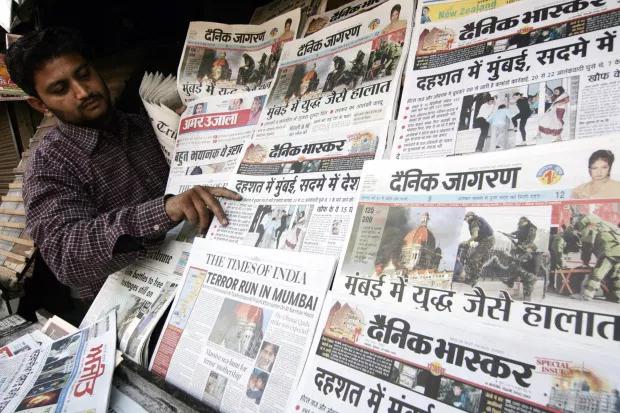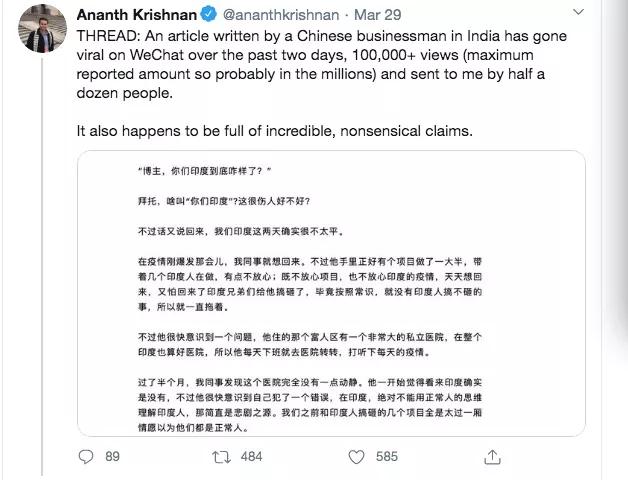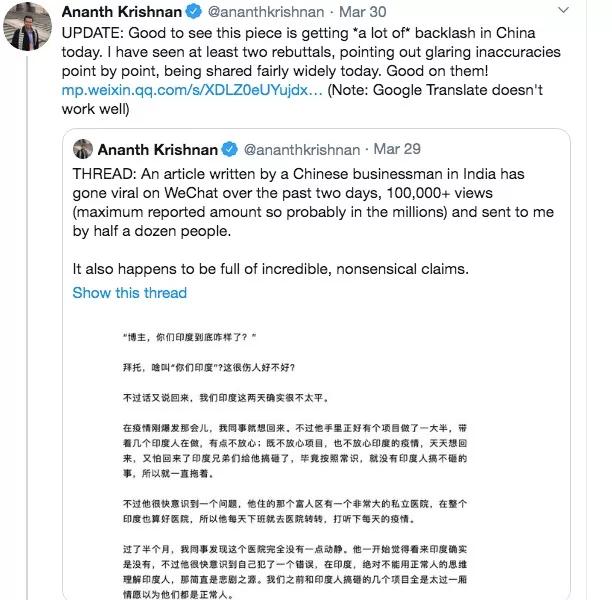I hope to help some friends who are interested in India, how to jump out of the pit-like WeChat reading environment and salvage quality Indian information.

The Indian story is back again. On March 28, a friend sent me “India is really going to fall into a pit this time”, with a greeting: Is it true? This seemingly simple question is difficult to answer: you can hardly find tangible information from it. Except for India, the full text does not have any accurate time, place, and person. I ca n’t answer it. Is he a fact or an author playing? .
This does not prevent it from gaining 100,000+. The public name of this article is “Jiubian”. A month ago, he also made another 100,000 + “In the face of epidemic, why India can lie down and win.” During the epidemic, another 100,000+ related to India was “Why are Indians so immune?”
The memory of the Internet is short, but it is still there. The 100,000+ of the “Jiubian” is the same as the 100,000+ of the last article: India is dirty, the Indian is chaotic, and the Indians are not reliable. The “Jiubian” concluded that the Indians should fall into the pit ; Another article argues that Indians thus have superhuman immunity and can escape birth. The reduction of the same “facts” leads to diametrically opposite conclusions, which does not prevent them from rushing on the road of harvesting 100,000+.
The spread of such fake news has disrupted the lives of Chinese in India. Imagine, if you live in the “India” of the explosion, will your relatives and friends in China be afraid of you?
Lang Dali said, “India is our patriotic education base,” a friend who worked in Mumbai said very accurately. “Jiubian” is actually doing “patriotic” business. Such traffickers rely on cutting, fabricating, and even imagining to create a weak and ridiculous other to stimulate our reading.
In addition, what I want to say is that there is also a romantic imagination of India in the domestic intellectual circle. Like Li Yinuo ’s “slave society”, it has been written because India has a world-class CEO, and both Received an undergraduate education in India, so he concluded that higher education in India is higher than China. This kind of “black” or “holding” India’s explosion is essentially a traffic business. He does not help us objectively understand an extremely complicated neighbor.
Of course, the purpose of writing this article is to help some friends who are interested in India, how to get out of the dunghill-like WeChat reading environment and salvage quality Indian information.
How to identify “explosive” in IndiaSection “
“India is really going to fall into a pit this time” also caused a secondary disaster. On March 29, Ananth Krishnan, a former journalist based in China, wrote an article on China and India, What Did WeChat Explosion Tell Us ?, published in the Hindu Newspaper.
The motivation for Anash Krishnan to write this article is because almost every Chinese friend he knows has changed. An explosive article with a traffic number attracted criticism from well-known foreign journalists. I don’t know if this is the first time in the history of WeChat.

After Anash Krishnan posted the article to Twitter, the public opinion secondary disaster of the “Jiubian” account occurred abroad. At present, the epidemic is spreading in India, and racist sentiments against the Chinese are rising on the Internet.
A message from a netizen in India should drive out Chinese in India.
Some netizens also pointed out humorously whether the “Indian blogger” who claimed to have been to India was like Columbus, thinking that when he arrived in India, he actually went to America.

However, the response of domestic netizens, especially the rebuttals from two Chinese living in India, partly played down the bad influence of the “Nine Sides” outside the wall. Anash Krishnan also transferred one of them to his Twitter.

The response came from two of my close friends. One is President Zheng, who works in Mumbai. He has lived in Mumbai for more than four years. The other is Wu Xiaoyin in Delhi. Both have clarified some core details, especially those that are widely spread on the InternetFallacy. For example, the author’s “White Bull Index”.
Return to the topic. Both authors live in India, and for a period of time, domestic readers cannot have this condition. Then, even if you have not been to India and have no common sense about India, can you judge from the perspective of journalism professionalism, This type of explosion is not worth your click?
The answer is, you can.
Media reports are divided into two categories, one is news, and the other is comments, which are opinions. A strict distinction between facts and opinions, and even comments must be based on facts. The so-called facts are the most basic requirements of journalists.
In terms of subject matter, “India is really going to fall into a pit this time.” If it is compared with the news norms, it belongs to the comment. But what is its factual basis? Read the full text, you can hardly find an exact time, place and name.
I have to say, “Why are Indians so immune?” “On the way of editing facts, work harder than the” nine sides. ” He at least screenshots the source of the information cited. But the flaws are still obvious. The immunity of Indians is really superman? We do a little search and it is easy to verify. For example, a 2008 research report by the US RAND Corporation “Comparison of Chinese and Indian Health Systems” showed that in India, people who died of infectious diseases More than 40% of the total number of deaths
How to get high-quality news in India
It is not difficult to find that the self-media articles on WeChat are actually from Indian media. The best way to avoid being brought into the pit by so-called “Indian bloggers” is to read the English reports of Indian media directly. And, to tell you the good news, none of their websites have been blocked.
India ’s media industry is very developed and competition is fierce. Taking the print media as an example, the Times of India, Hindustan Times, and The Hindu are the three national daily newspapers. In addition, like the Indian Express ( The Indian Express) and Deccan Herald, although not distributed nationwide, are not influential. In addition, India Today, which started as a magazine, is a national media group. Except for the Deccan Herald, the remaining five make up India’s five largest English media groups.
In the field of financial media, the Economic Times and Mint have a status similar to 21st Century Business Herald and First Business News before 2010.
A simple conclusion can be made. Although India’s economy ranks fifth in the world, the media industry is quite developed. Whether fromThe circulation of newspapers or the number of television stations is an indicator that India is far ahead. On the other hand, India’s media is confined to the domestic market, and they have not yet produced global influential media. Because India’s economy is not enough to support a global media group, and the professionalism of Indian media needs to be improved. Especially after Modi came to power, the politician who started from BJP’s propaganda officer was very good at tame and disobedient media, and the independence of Indian media was damaged.
After the popularization of science, I want to share how I obtained quality information.
The Times of India and the Indian Economic Times are two newspapers I must read. Every morning, I will browse half an hour to forty minutes to find out what’s happening in India. Because of work, the Indian Economic Times will take it more seriously. In addition, Twitter is my main channel for getting information. Breaking news from India will be seen immediately on Twitter. I subscribe to almost all major media Twitter accounts, as well as some journalists who share information outside the news. I have to say that compared to WeChat, the quality of Twitter is indeed much better.
If you want to know what Indian intellectuals think of certain public topics, I will read the Indian Express. His commentary is well-known in India, and several world-class scholars have worked in the Indian Express, such as Amitav Ghosh, author of the Opium War trilogy, and he graduated from the University of Delhi The first job after that was as a reporter for the Indian Express.
However, the most respected Indian media is The Caravan, which is rarely known in the country. This is the only non-fiction news magazine in India. It can be described as the New Yorker in India. His own editorial team is very limited, but the author group is spread all over the world. Like Roy, the first author of the Booker Award in India, he often writes for Caravan. If you want to learn about an in-depth social topic in India, Caravan is your best choice. Its only disadvantage is that the article is too long. Take the cover article as an example, it is usually about 10 pages. In addition to its in-depth coverage, The Caravan is very daring to say that it is rare in India right now. In mid-2018, The Caravan published a report pointing to the son of BJP party leader Amit Sha, who was suspected of corruption and had brought lawsuits.
If you do n’t have basic knowledge about India ’s national conditions, there may be some obstacles to reading Indian media reports at first. After all, the preset readership of Indian local media is mainly Indians. If you’re just interested in India, check out the Financial Times, The Wall Street Journal, The New York Times, or The Economist for most information needs. I read Western media reports. In addition to supplementing the amount of information, I still want to understand how India is interpreted externally. This is the “nutrition balance” of some kind of information.
Also, I subscribe